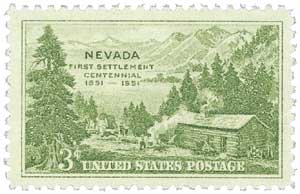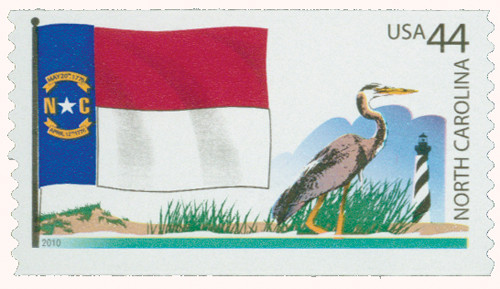
# 4306 - 2010 44c Flags of Our Nation: Nevada
Flags of Our Nation
Nevada
City: New York, NY
Printing Method: Photogravure
Perforations: Serpentine Die Cut 11 vertically
Nevada Becomes 36th State
American Indians may have lived in the Nevada region more than 20,000 years ago, making this area home to some of the earliest Indians in the United States. In southern Nevada, Indians left picture writing on rocks that date back thousands of years. Nevada tribes include the Pueblo, Mohave, Paiute, Shoshone, and Washoe.
Historians believe Francisco Garcés was the first white man to reach Nevada. In 1776, Garcés went through the region while traveling from New Mexico to California. Between 1825 and 1830, many fur trappers came to Nevada. William Wolfskill blazed the Old Spanish Trail from Santa Fe to Los Angeles. This route made it possible for people in Nevada to trade with the southeast.
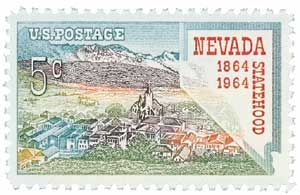
A trapper, Joseph Walker, blazed an important trail along the Humboldt River from Nevada to California in 1833. When gold was discovered in 1848, thousands of people followed this trail west to stake a claim. From 1843 to 1845, Lieutenant John C. Frémont mapped Nevada with Kit Carson as his guide.
The United States acquired Nevada from Mexico at the end of the Mexican War in 1848. It was governed as part of a vast territory that included California, Utah, and parts of four other states. The Mormon leader Brigham Young organized the State of Deseret in 1849. Deseret included Utah, most of Nevada, and parts of other U.S. states. Young asked the federal government to admit Deseret to the Union. Instead, in 1850, Congress created the Utah Territory, which included Utah and most of Nevada, and named Young governor.
Starting in 1851, large numbers of Mormons began moving to the Carson Valley in Nevada. They established a trading post called Mormon Station for people traveling west to California to find gold. Mormon Station later became Genoa, the oldest permanent white settlement in Utah.
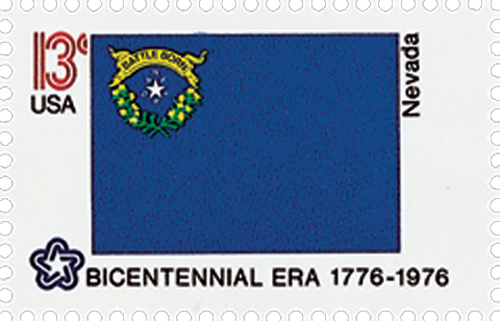
Carson Valley was organized as Carson County. However, non-Mormon citizens of Carson County did not want to be governed by Young. They petitioned Congress to make Carson County part of California. In 1857, Young asked Mormons in the area to move to Great Salt Lake due to fear of an attack by the federal government. Two years later, non-Mormons organized a separate government for Carson County and attempted to establish it as a distinct territory. However, the federal government refused to recognize the territory, due to its extremely limited population.
In 1859, a rich deposit of silver ore was discovered at the present site of Virginia City. Although other miners had discovered the silver, Henry Comstock took credit for finding the ore. Thus, this deposit became known as the Comstock Lode.
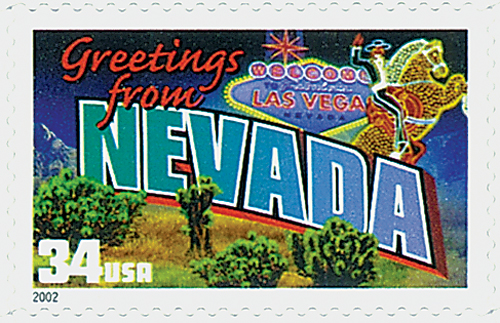
News of the discovery spread fast, and soon miners from California and the Eastern U.S. flocked to the area looking to strike it rich. Virginia City quickly became a thriving mining center.
The miners didn’t have an easy life. Provisions had to be shipped from California over the Sierra Nevada Mountains and were very expensive. Although some miners became millionaires, others found little or no wealth. Many of the miners were criminals, and lawlessness made the mining camps a dangerous place to live. Nevertheless, by 1860, Carson County’s mining camps held more than 6,700 people.
On March 2, 1861, President James Buchanan created the Nevada Territory. Two days later, President Abraham Lincoln took office. Lincoln named New York politician James W. Nye the territory’s first governor. The Civil War erupted before the territorial government could be established. Nevada’s rich silver resources gained importance during the war, as both sides needed wealth to pay for the expense of waging battle.
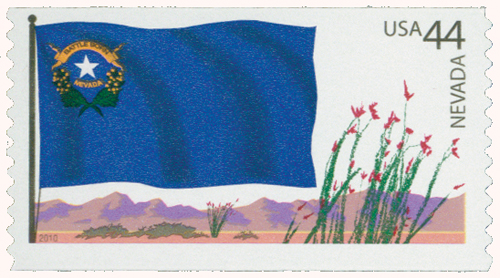
Most Nevadans favored the Northern cause. Lincoln was anxious to admit another state to the Union so that he would be able to pass his proposed slavery amendments to the U.S. Constitution. Despite the fact that Nevada did not have the required number of people to become a state, Nevadans held a convention to create a state constitution. The first convention, held in November 1863, met with failure. The second convention, held in July 1864, was a success. There was a rush to grant the territory statehood in order to help Lincoln’s re-election bid in 1864. To that end, the entire state constitution was sent to Washington, D.C., by telegraph. It was a process that took more than seven hours to transmit. Statehood was gained just eight days before the election, on October 31, 1864, with the Civil War still raging. This led to Nevada’s nickname “Battle Born,” which is featured on the state flag.
From 1870 until 1900, Nevada entered a period of economic decline. Silver mining became less profitable, and many mines closed. Cattle ranchers suffered, due to the high cost of shipping their livestock by rail. Between 1880 and 1890, the state’s population dropped from 62,266 to 47,355.
Around 1900, new mineral resources were discovered, and the economic tide turned. Silver was discovered at Tonopah. Cooper was found at Ely, Ruth, and Mountain City. Gold was discovered at Goldfield in 1902. Miners returned to the state in large numbers.
Railroads built new lines. This improved rail service also benefitted the ranchers. Dams and irrigation projects on the Carson and Truckee rivers improved the state’s infrastructure. By 1917, when the U.S. entered World War I, the state’s silver and gold mines were nearly exhausted. But the war created demand for the mining of copper, tungsten, zinc, and other metals.
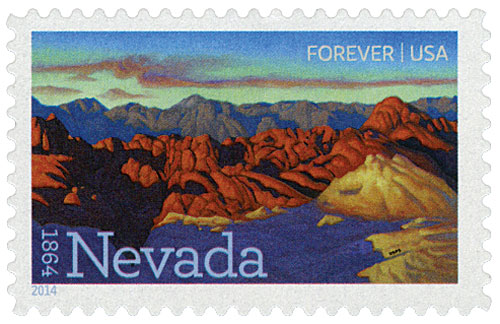
In 1928, the U.S. Congress authorized the construction of the gigantic Hoover Dam on the Colorado River. Completed in 1936, this dam is a source of power and also stores irrigation water for Nevada, Arizona, and California.
Tourism, fueled by gambling, is Nevada’s largest and fastest-growing industry. As early as the 1960s, Las Vegas alone attracted 15 million tourists each year. Because of this tourist industry, Nevada has become a “two-city” state, as four-fifths of the people live in the Las Vegas and Reno-Lake Tahoe areas. These city areas face many of the same problems facing metropolitan areas across the U.S., including: demand for better police and fire protection, improved educational facilities, better opportunities for minorities, and control of air and water pollution.
Flags of Our Nation
Nevada
City: New York, NY
Printing Method: Photogravure
Perforations: Serpentine Die Cut 11 vertically
Nevada Becomes 36th State
American Indians may have lived in the Nevada region more than 20,000 years ago, making this area home to some of the earliest Indians in the United States. In southern Nevada, Indians left picture writing on rocks that date back thousands of years. Nevada tribes include the Pueblo, Mohave, Paiute, Shoshone, and Washoe.
Historians believe Francisco Garcés was the first white man to reach Nevada. In 1776, Garcés went through the region while traveling from New Mexico to California. Between 1825 and 1830, many fur trappers came to Nevada. William Wolfskill blazed the Old Spanish Trail from Santa Fe to Los Angeles. This route made it possible for people in Nevada to trade with the southeast.

A trapper, Joseph Walker, blazed an important trail along the Humboldt River from Nevada to California in 1833. When gold was discovered in 1848, thousands of people followed this trail west to stake a claim. From 1843 to 1845, Lieutenant John C. Frémont mapped Nevada with Kit Carson as his guide.
The United States acquired Nevada from Mexico at the end of the Mexican War in 1848. It was governed as part of a vast territory that included California, Utah, and parts of four other states. The Mormon leader Brigham Young organized the State of Deseret in 1849. Deseret included Utah, most of Nevada, and parts of other U.S. states. Young asked the federal government to admit Deseret to the Union. Instead, in 1850, Congress created the Utah Territory, which included Utah and most of Nevada, and named Young governor.
Starting in 1851, large numbers of Mormons began moving to the Carson Valley in Nevada. They established a trading post called Mormon Station for people traveling west to California to find gold. Mormon Station later became Genoa, the oldest permanent white settlement in Utah.

Carson Valley was organized as Carson County. However, non-Mormon citizens of Carson County did not want to be governed by Young. They petitioned Congress to make Carson County part of California. In 1857, Young asked Mormons in the area to move to Great Salt Lake due to fear of an attack by the federal government. Two years later, non-Mormons organized a separate government for Carson County and attempted to establish it as a distinct territory. However, the federal government refused to recognize the territory, due to its extremely limited population.
In 1859, a rich deposit of silver ore was discovered at the present site of Virginia City. Although other miners had discovered the silver, Henry Comstock took credit for finding the ore. Thus, this deposit became known as the Comstock Lode.

News of the discovery spread fast, and soon miners from California and the Eastern U.S. flocked to the area looking to strike it rich. Virginia City quickly became a thriving mining center.
The miners didn’t have an easy life. Provisions had to be shipped from California over the Sierra Nevada Mountains and were very expensive. Although some miners became millionaires, others found little or no wealth. Many of the miners were criminals, and lawlessness made the mining camps a dangerous place to live. Nevertheless, by 1860, Carson County’s mining camps held more than 6,700 people.
On March 2, 1861, President James Buchanan created the Nevada Territory. Two days later, President Abraham Lincoln took office. Lincoln named New York politician James W. Nye the territory’s first governor. The Civil War erupted before the territorial government could be established. Nevada’s rich silver resources gained importance during the war, as both sides needed wealth to pay for the expense of waging battle.

Most Nevadans favored the Northern cause. Lincoln was anxious to admit another state to the Union so that he would be able to pass his proposed slavery amendments to the U.S. Constitution. Despite the fact that Nevada did not have the required number of people to become a state, Nevadans held a convention to create a state constitution. The first convention, held in November 1863, met with failure. The second convention, held in July 1864, was a success. There was a rush to grant the territory statehood in order to help Lincoln’s re-election bid in 1864. To that end, the entire state constitution was sent to Washington, D.C., by telegraph. It was a process that took more than seven hours to transmit. Statehood was gained just eight days before the election, on October 31, 1864, with the Civil War still raging. This led to Nevada’s nickname “Battle Born,” which is featured on the state flag.
From 1870 until 1900, Nevada entered a period of economic decline. Silver mining became less profitable, and many mines closed. Cattle ranchers suffered, due to the high cost of shipping their livestock by rail. Between 1880 and 1890, the state’s population dropped from 62,266 to 47,355.
Around 1900, new mineral resources were discovered, and the economic tide turned. Silver was discovered at Tonopah. Cooper was found at Ely, Ruth, and Mountain City. Gold was discovered at Goldfield in 1902. Miners returned to the state in large numbers.
Railroads built new lines. This improved rail service also benefitted the ranchers. Dams and irrigation projects on the Carson and Truckee rivers improved the state’s infrastructure. By 1917, when the U.S. entered World War I, the state’s silver and gold mines were nearly exhausted. But the war created demand for the mining of copper, tungsten, zinc, and other metals.

In 1928, the U.S. Congress authorized the construction of the gigantic Hoover Dam on the Colorado River. Completed in 1936, this dam is a source of power and also stores irrigation water for Nevada, Arizona, and California.
Tourism, fueled by gambling, is Nevada’s largest and fastest-growing industry. As early as the 1960s, Las Vegas alone attracted 15 million tourists each year. Because of this tourist industry, Nevada has become a “two-city” state, as four-fifths of the people live in the Las Vegas and Reno-Lake Tahoe areas. These city areas face many of the same problems facing metropolitan areas across the U.S., including: demand for better police and fire protection, improved educational facilities, better opportunities for minorities, and control of air and water pollution.






